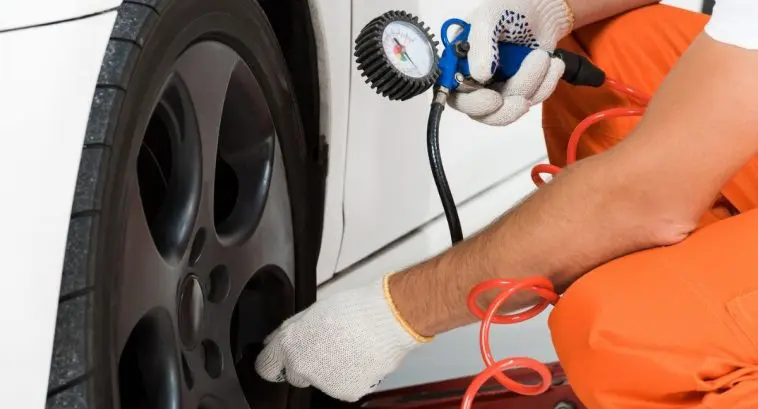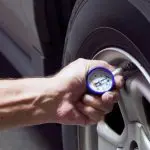For your car tires to operate correctly, they should have the correct amount of pressure, and therefore, you should always maintain the correct pressure.
This not only serves you for a long time but also ensures that fuel efficiency is increased.
Technology has made it easy for you to monitor tire pressure because modern cars are fitted with pressure monitoring systems that notify you as soon as possible.
Even with that, the system may fail occasionally and send you wrong signals.
The tire pressure monitoring system illuminates when giving indications on low tire pressure, and this only happens when your tire pressure is below 25%.
As stated above, your TPMS may give you wrong signals, and below are reasons as to why that happens:
- Your Tire Pressure Monitoring System May Be Destroyed
- In Case You Have Had A Recent Tire Replacement
- Driving In Extreme Cold Weather Conditions
- Your TPMS Batteries May Be Low
- Damaged Tire Because Of Tire Sealants
- Low Pressure In The Spare Tire
- In Case Your System Gets Short-Circuited
Therefore, it is good to ensure that your car tire pressure is always at the required amount to avoid signals from your tire pressure monitoring system.
If the signal persists, check on the issues mentioned above or contact your mechanic. Always ensure the Tire Pressure Monitoring System is in good working condition at all times.
TABLE OF CONTENTS
How Does A Tire Pressure Monitoring System (TPSM) Work?
Assuming that your tire pressure sends you false signals, you should understand how the Tire Pressure Monitoring System works as a driver.
This device has a primary function to monitor the tire pressure in all tires of your vehicle.
It gives you warnings by sending light signals or audio signals if your car is of the latest model through the instrument cluster when your tire pressure reaches a certain level.
To have the know-how, first, you should know there are two types of Tire Pressure Monitoring Systems used by different manufacturers in their vehicles.
Type 1: Direct Tire Pressure Monitoring System
These systems are mounted to your rims, and their main function is to measure the internal pressure of your tires.
These sensors act like physical pressure sensors attached beneath the valve stem or used as strips by placement on the rim recess. The sensor monitors your tire pressure.
When it goes below 25%, which is below the manufacturer’s recommended level, the sensor is triggered to transmit information to your car’s computer, which in turn triggers the dashboard light.
Type 2: Indirect Tire Pressure Monitoring System
These are the types of systems that work using ABS sensors rather than measuring your car’s wheel diameter.
When your car tire deflates, the diameter reduces, and this means that it will have a fast turning rate than the other wheels.
Therefore the system uses your vehicles Antilock Braking System (ABS) since the deflated tire will roll faster than other wheels.
The information is detected and sent to your vehicle’s computer, and then the indicator light on the dashboard is triggered.
The biggest setback to this system is that, because it uses other tires size as a point of reference, you will not get a warning if all four tires have a deflation.
Is It Okay To Drive With Tire Pressure Light On?
It is not safe for you to drive with the pressure light because it means that your tire is deflated or over-inflated.
You are therefore advised to use your car manual to find the correct tire pressure for your vehicle.
Driving with a deflated or over-inflated tire will cause them to wear unevenly or lead to potential tire failure, which may cause a blowout dangerous to both road users and you.
You should also be aware that different pressure light indicators indicate differently.
How Long Can You Go With Tire Pressure Light On?
Assuming that you have inflated your tires after you received an indication of low pressure, the light may go off after you drive few miles.
If it doesn’t turn off after you have driven for about 10 miles, you need to reset your TPMS by following the vehicle manual.
If the light is still on and all your tires are in the required conditions, the chances are that your Tire Pressure Monitoring System has malfunctioned and needs replacement.
What Makes My Tire Pressure Light On When My Tires Are Fine?
Under some circumstances, you may be unfortunate to receive the pressure indication lights on your dashboard even when the tires are not flat.
Below are some of the possible reasons as to why the tire pressure light is on:
1. Your Tire Pressure Monitoring System May Be Destroyed
In cases where you start your car engine, and the tire pressure light comes on permanently may be an indicator that your Tire Pressure Monitoring System is damaged.
You can check it by yourself by following the manual of your vehicle, and if it seems difficult, then contact your mechanic.
If the tire pressure is of the required level, then you should replace the faulty TPMS.
2. In Case You Have Had A Recent Tire Replacement
Because your TPMS tool is located on the tire rims when you change your tires, you may damage it, which means you will receive a continuous pressure light indicator.
Therefore, you should check your pressure light in the event of changing your tire.
Your TPMS tool gets damaged when you change your tire in the sense that the electronic box is tampered with.
3. Driving In Extreme Cold Weather Conditions
In most cases, when the weather condition is too cold, your vehicle’s tire pressure reduces because science states at extremely low temperatures matter compress, and the reverse is true.
Therefore, expect your tire pressure light to be on in case you are driving in cold conditions even if your tire pressure is correct.
The condition will persist for a while until your tires become warm, and if the light doesn’t go off, you should measure your tire pressure.
4. Your TPMS Batteries May Be Low
You should be aware that your Tire Pressure Monitoring Systems battery has a lifespan of 6 to 10 years, and after this period, they become weak, which may lead to signal interruption.
In such events, the tire pressure light will be forced to illuminate even if your tires are in good condition.
5. Damaged Tire Because Of Tire Sealants
Assuming that you were repairing your tire that may have gone over a nail as you were driving, you are required to use a tire sealant, and if this sealant gets its way into the air in the tire, it may destroy the Tire Pressure Monitoring Sensors.
If the sensor is destroyed, then there is no way a faulty sensor will work, which means it will be giving you unrequired signals on your dashboard because of its failure.
6. Low Pressure In The Spare Tire
Assuming that you replaced your tire, some tires may have pressure sensors, and their pressure might cause below.
Forgetting to evaluate the pressure of your spare tire is normal, and this happens when you are regulating the pressure of the other active tires.
Therefore, low pressure in an uninspected spare tire may lead to pressure light signals on your vehicle.
7. In Case Your System Gets Short-Circuited
A Tire Pressure Monitoring System is an electronic device, and this means that they can experience internal faults or short-circuiting.
If this happens, the system stops functioning, which means there will be no signaling to the dashboard, and this means that the low-pressure light will be turned on.
Therefore, you should ensure that your TPMS is in good working condition at all times because it is a vital element in your vehicle.
Replace the system if damaged immediately to reduce curiosity.
What Are The Dangers Of Driving With The Low Tire Pressure Light On?
As discussed before, once you receive an indicator showing that your tire pressure is low, it is no longer safe for you to drive with that warning.
Take quick action to ascertain what the reason behind the signal is.
If you drive with this signal on, below are some of the dangers you are likely to meet:
- You are at risk of having tire failure because one of your car wheels may be underinflated, which may lead to tire bursting, which may lead to fatal accidents. Therefore, you should never ignore TPMS signals.
- In case you have overinflated tires have reduced traction, they cannot well absorb the impact from the road, which means that wear fast, which will lead to increased cost for purchasing other tires.
- If your tire is under-inflated, you are at risk because you will be experiencing slow response and lead to increases in heat production because of the friction force leading to fuel wastage and overloading.
How Do You Know If Your Tire Pressure Sensor Is Bad?
Assuming that you have been receiving tire pressure light signals because of a deflated tire after you have replaced the tire or inflating the tire to the required pressure level, the TPMS sensors detect the new pressure levels of the tire means the light should go off.
In case the light does not go off and you have checked your car of any leaks, and there are none, your tire pressure is stable, indicating that your pressure sensor is damaged and needs immediate replacement.
4 Steps To Troubleshoot Your Tire Pressure Monitoring System
Assuming that your tire pressure light is on even though your tire pressure is correct, you are advised to reset or troubleshoot the Tire Pressure Monitoring System to do away with low tire pressure light even if all tires are fine.
- Locate your TPMS reset button and then turn your key on without starting your engine.
- After that, press and firmly hold the reset button until the flashlight is off.
- In case the light remains persistent, and the conditions of your tires are okay, press and firmly hold the reset button until the pressure light blinks three times and then shut down your engine.
- After performing the above steps, you are required to drive your vehicle at a speed that is not below 19 mph for 60 minutes to ensure your Tire Pressure Monitoring System is completely reset.
In case the steps listed above fail, you are required to visit a professional mechanic who will determine the main cause of the persistent indication, which may be because of a faulty TPMS and needs replacement.
In some cases, it may be because of electrical problems.
9 Tips To Maintain Your TPMS
Because your tires are the only parts in constant contact with the surface, make sure they are not over-inflated or under-inflated to ensure your safety.
Your TPMS tool plays a vital role in simplifying your work by signaling when the pressure is low.
You should know what is needed from you to keep this machine functional at all costs, and if you have a challenge in doing this, then seek mechanical help immediately.
Below are some maintenance tips for your TPMS:
- After covering a maximum of 6000 to 8000 miles, make sure you rotate the tire.
- After replacing your tires, make sure you do tire balancing, and this requires a certified and professional mechanic to do that.
- In case you want your tires replaced or serviced, make sure a reputable dealer does the process because they know about carefully servicing and replacing the wheels. This means they will do the procedure with great care, thus doing no damage to your TPMS.
- Assuming that you are replacing OEM wheels, you need qualified mechanics because the procedure is tedious. You need to replace the wheels with a large aftermarket wheel, which to some point, interferes with the factory settings of your TPMS.
- It is important to replace damaged, old, and worn out tires immediately because it is a safety measure not to forget that traffic rules will not allow you to drive your car with poor tire conditions. Depending on what location you are, you may be fined because of this.
- You are advised to check your vehicle’s tire alignment for every 4350 miles to prevent uneven tire wearing.
- Evaluate your vehicle’s tire pressure a routine and make sure you inflate your tire to the required level before resetting your TPMS light.
- Check your tire pressure every week or monthly to make sure that your car uses the recommended tire pressure.
- Ensure your car tires have proper tread depths to facilitate optimum gripping to ensure the vehicle moves properly.
Conclusion
As a driver, your peace is destroyed once you start receiving false warning signals from your TPMS. As a qualified driver, you must take the necessary steps to get rid of the condition.
This article has discussed some steps that will help you overcome the condition, and if you correctly use them, then be sure to succeed but keep in mind that some issues need the help of an expert.
Remember to perform a routine check-up on your tires to keep your vehicle in good form, and this keeps your car in a good driving condition and serves your personal interests fully.
Sources:
1. OBD Advisor – https://www.obdadvisor.com/low-tire-pressure-light-is-on-but-tires-are-fine/
2. Car Understanding – http://carunderstanding.com/low-tire-pressure-light-but-tires-are-fine/




